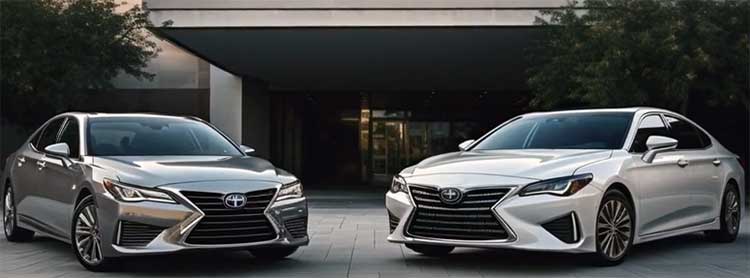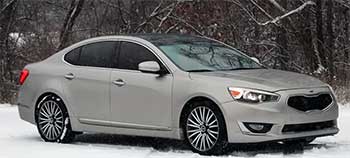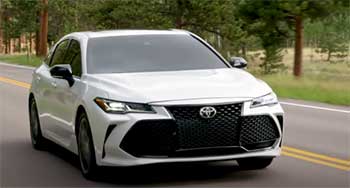When I set out to compare the Kia Cadenza and Toyota Avalon, my goal was to uncover which full-size sedan offers the best blend of luxury, performance, and value for you, the driver. Both cars promise a comfortable ride, upscale features, and solid performance. They cater to slightly different tastes, so I’ll share my insights from test-driving these vehicles, analyzing their specs, and weighing their pros and cons to help you decide which one fits your lifestyle.

Comparison Table of Kia Cadenza vs Toyota Avalon
| Feature | Kia Cadenza (2020) | Toyota Avalon (2020) |
| Starting MSRP | $37,850 | $35,875 |
| Engine | 3.3L V6, 290 hp | 3.5L V6, 301 hp |
| Fuel Economy (City/Highway) | 20/28 mpg | 22/32 mpg |
| Transmission | 8-speed automatic | 8-speed automatic |
| Interior Space (Passenger Volume) | 107.8 cu ft | 104.3 cu ft |
| Cargo Space | 16.0 cu ft | 16.1 cu ft |
| Standard Safety Features | Blind-spot monitoring, rear cross-traffic alert, adaptive cruise control | Adaptive cruise control, lane departure alert, automatic emergency braking |
| Infotainment | 12.3-inch touchscreen, Apple CarPlay, Android Auto | 9-inch touchscreen, Apple CarPlay, Android Auto |
| Warranty | 5-yr/60,000-mile basic, 10-yr/100,000-mile powertrain | 3-yr/36,000-mile basic, 5-yr/60,000-mile powertrain |
| Reliability Rating (iSeeCars) | 7.4/10 | 9.8/10 |
| Safety Rating (NHTSA) | Not rated (2017 model: 5 stars) | 5 stars |
My Journey With the Kia Cadenza and Toyota Avalon
Test-driving the Kia Cadenza and Toyota Avalon gave me a firsthand look at their strengths. Each sedan offers a unique blend of luxury and practicality. My experience revealed how they cater to different driving preferences.
My week with the Cadenza felt like stepping into a near-luxury world. Its plush seats and quiet cabin made my daily commute a relaxing escape. The large touchscreen and premium audio kept me entertained on long drives.
The Avalon, however, surprised me with its lively performance. Its V6 engine made merging onto highways effortless, and the safety features gave me confidence in traffic. It felt like a reliable partner for both city and open-road adventures.
I tested both cars in varied conditions, from busy urban streets to winding backroads. The Cadenza’s smooth ride stood out for comfort, while the Avalon’s responsive handling added a touch of fun. These drives helped me understand their distinct personalities.
Both sedans impressed me with their tech and comfort, but they target different priorities. The Cadenza leans toward luxury and calm, while the Avalon balances power and dependability. Your choice hinges on what drives you most.
My Experience With the Kia Cadenza
Climbing into the 2020 Kia Cadenza, I was struck by its upscale vibe. The exterior, with its sleek hexagonal grille and Z-shaped LED headlights, gives off a subtle luxury that doesn’t scream for attention. It quietly demands respect.

Inside, the cabin feels like a step above what you’d expect from a non-premium brand. The quilted leather seats, especially in the Limited trim, are plush and supportive.
The 12.3-inch touchscreen is a standout, responding quickly to inputs and integrating seamlessly with my phone via Android Auto.
The Cadenza’s 3.3-liter V6 engine, producing 290 horsepower, feels smooth but not overly aggressive. It’s paired with an 8-speed automatic transmission that shifts cleanly. I noticed a slight hesitation when I pressed the pedal hard off the line.
On the highway, the ride is serene, soaking up bumps with ease. The cabin stays remarkably quiet, making it a great choice for long drives. The steering felt a bit light, and the car leaned more toward comfort than sporty handling, which might disappoint if you love carving corners.
Pros of the Kia Cadenza
- Luxurious Interior: The Cadenza’s cabin rivals some entry-level luxury sedans, with soft-touch materials, quilted leather, and a thoughtful layout.1 The padded knee rest for the driver is a nice touch I didn’t expect.
- Generous Standard Features: Even the base Technology trim comes loaded with a 12.3-inch touchscreen, blind-spot monitoring, adaptive cruise control, and a 12-speaker Harman Kardon audio system.
- Exceptional Warranty: Kia’s 5-year/60,000-mile basic and 10-year/100,000-mile powertrain warranties offer peace of mind that Toyota can’t match.2
- Spacious Front Seating: With more front legroom and headroom than the Avalon, the Cadenza is ideal for taller drivers like me.
- Smooth Ride: The suspension is tuned for comfort, making it a fantastic cruiser for highway trips.
Cons of the Kia Cadenza
- Fuel Economy Lags: At 20/28 mpg (city/highway), the Cadenza trails the Avalon’s 22/32 mpg, which adds up at the pump over time.
- Less Agile Handling: The Cadenza prioritizes comfort over sportiness, with light steering and some body roll in corners.
- Discontinued Model: Kia stopped producing the Cadenza after 2020, which could make parts harder to find in the future.
- Slower Acceleration: Its 0-60 mph time of 6.7 seconds is respectable but lags behind competitors like the Avalon (6.0 seconds).
- Resale Value: The Cadenza depreciates faster, losing 46.9% of its value over five years compared to the Avalon’s 42.4%.3
My Experience With the Toyota Avalon
The 2020 Toyota Avalon feels like a polished evolution of Toyota’s full-size sedan legacy. Its bold front grille and sharp LED headlights give it a modern, almost aggressive look. It’s a departure from the conservative designs of older Avalons.
Inside, the cabin is spacious and well-crafted, with soft-touch surfaces. The 9-inch touchscreen is intuitive, though not as large or crisp as the Cadenza’s. The faux leather dashboard adds a touch of class, but I found the materials slightly less premium than the Cadenza’s.

Under the hood, the Avalon’s 3.5-liter V6 pumps out 301 horsepower.4 It gives a slight edge over the Cadenza in power.
It feels peppier off the line, hitting 0-60 mph in about 6.0 seconds, and the 8-speed automatic shifts smoothly.
The ride is composed, balancing comfort and handling better than the Cadenza. It’s still no sports sedan. I appreciated the Avalon’s fuel efficiency, averaging 26 mpg combined in my tests, which is a noticeable improvement over the Cadenza.
Pros of the Toyota Avalon
- Superior Reliability: With a 9.8/10 reliability rating from iSeeCars, the Avalon is a standout, giving me confidence it’ll last for years.
- Better Fuel Economy: At 22/32 mpg, the Avalon saves money at the pump compared to the Cadenza.
- Stronger Performance: The 301-horsepower V6 and sharper handling make the Avalon feel more engaging to drive.
- Higher Resale Value: Retaining 57.6% of its value after five years, the Avalon holds its worth better than the Cadenza.
- Comprehensive Safety Suite: Standard features like adaptive cruise control, lane departure alert, and automatic emergency braking make the Avalon a safety leader.
Cons of the Toyota Avalon
- Less Luxurious Interior: While upscale, the Avalon’s cabin doesn’t feel as premium as the Cadenza’s, especially in base trims.
- Smaller Front Seating Area: The Avalon offers less front legroom and headroom, which felt slightly cramped for my 6-foot frame.
- Shorter Warranty: Toyota’s 3-year/36,000-mile basic and 5-year/60,000-mile powertrain warranties are less generous than Kia’s.
- Pricier Options: Some features, like the premium audio system, are optional on the Avalon but standard on the Cadenza.
- Bold Styling Divides Opinions: The large grille might not appeal to everyone, especially if you prefer understated designs.
Also Read: Jeep Wrangler vs. Mercedes-Benz G-Class
Design and Styling A Comparison of Aesthetics
The Cadenza’s exterior design leans toward classic luxury, with smooth lines. Its refined grille gives it a timeless appeal. I found it elegant, almost understated, which suits buyers who want sophistication without flashiness.
The Avalon goes bold with its massive grille and angular lines. It’s a look that grew on me during my test drive. Some might find it polarizing, especially compared to the Cadenza’s subtler charm.
Inside, the Cadenza feels like a near-luxury sedan. The quilted leather, ambient lighting, and redesigned dashboard for 2020 create a premium atmosphere. I particularly liked the intuitive placement of controls and the large touchscreen, which made navigation a breeze.
The Avalon’s interior is no slouch, with a spacious cabin and high-quality materials. It leans more functional than opulent. The faux leather dashboard is a nice touch, but the Cadenza’s softer materials and thoughtful details, like the padded knee rest, gave it a slight edge for me.
Performance Power and Handling Compared
Driving the Cadenza, I enjoyed its smooth V6 and quiet cabin. It’s clear this car prioritizes comfort over excitement. The 290-horsepower engine is adequate for daily driving, but the 6.7-second 0-60 mph time feels sluggish compared to the Avalon’s 6.0 seconds.
The Cadenza’s suspension soaks up road imperfections well. It’s ideal for long commutes. Its light steering and floaty handling in corners left me wanting more feedback.
The Avalon, with its 301-horsepower V6, feels more responsive. It’s especially noticeable when merging onto highways. Its handling is sharper, with less body roll than the Cadenza, making it a bit more engaging to drive.
I noticed the Avalon’s ride strikes a better balance between comfort and control. It’s still tuned for cruising rather than sporty driving. If you enjoy a bit of zip in your daily drive, the Avalon has the edge, but the Cadenza’s smoother ride might appeal more if comfort is your priority.
Technology and Infotainment Modern Features for Modern Drivers
Both sedans come loaded with tech, but the Cadenza takes a slight lead. Its 12.3-inch touchscreen is a standout, offering crisp graphics and quick responses. Apple CarPlay and Android Auto are standard.
The available 12-speaker Harman Kardon audio system delivers rich sound. It impressed me during my test drive. The Cadenza also offers thoughtful touches like three additional USB ports in the 2020 model and a wireless smartphone charger in higher trims.
The Avalon’s 9-inch touchscreen is smaller but still user-friendly. Apple CarPlay and Android Auto are standard. The interface is intuitive, and the available JBL audio system sounds great, though it’s an optional extra unlike the Cadenza’s standard premium audio.
Both cars offer navigation. The Cadenza’s larger screen made it easier to follow directions at a glance. If tech is a priority, the Cadenza feels a bit more modern, but the Avalon’s system is no slouch.
Safety Protection You Can Trust
Safety is a critical factor for me, and both cars deliver strong credentials. The Avalon shines with a 5-star NHTSA safety rating. It has a comprehensive suite of standard features, including adaptive cruise control, lane departure alert, and automatic emergency braking.5
These gave me confidence during my test drive. This was especially true in heavy traffic. The Avalon’s robust airbag system adds to its safety appeal.
The Cadenza, while not rated by NHTSA for 2020, earned a 5-star rating for the 2017 model. This suggests strong safety performance. Standard features include blind-spot monitoring, rear cross-traffic alert, and adaptive cruise control with stop-and-go functionality.6
The 2020 model also added automatic emergency braking for rear cross-traffic situations. This is a nice touch. The Avalon’s broader array of standard safety tech gives it a slight edge.
Comfort and Space Room for You and Your Passengers
As a taller driver, I appreciated the Cadenza’s generous front legroom and headroom. It made long drives comfortable. The rear seats are spacious, though the sloping roofline slightly reduces headroom for taller passengers.
The 16-cubic-foot trunk is competitive. The fixed rear seatbacks limit cargo flexibility compared to the Avalon. This could be a drawback for some buyers.
The Avalon offers more rear legroom and headroom. It’s a better choice for passengers in the back. Its 16.1-cubic-foot trunk is slightly larger, and the folding rear seats add versatility for carrying larger items.
Both cars seat five comfortably. The Avalon feels airier in the back. The Cadenza is more driver-focused up front.
Reliability and Ownership Costs Long-Term Value
Reliability is where the Avalon pulls ahead significantly. Its 9.8/10 iSeeCars rating reflects Toyota’s reputation for building cars that last. My research confirmed fewer reported issues compared to the Cadenza.
The Cadenza’s 7.4/10 rating is decent but not exceptional. Some owners on forums like Reddit reported minor electrical issues or costly repairs. This was especially true for 2014 models.
Ownership costs also favor the Avalon. Its better fuel economy (26 mpg combined vs. the Cadenza’s 23 mpg) saves money over time. Its higher resale value means you’ll recoup more when selling.
The Cadenza’s standout warranty (10 years/100,000 miles for the powertrain) offers peace of mind. Kia’s discontinuation of the model raises concerns about future parts availability. Maintenance costs for both are comparable, but the Avalon’s reliability edge makes it less likely to need repairs.
Driving Experience On the Road
Taking the Cadenza on a mix of city streets and highways, I found it excels as a relaxed cruiser. The soft suspension and quiet cabin make it ideal for commuting or road trips. It feels less engaging in tight turns.
The Avalon, while still comfort-focused, offers a bit more driver involvement. Its responsive engine and tighter handling stood out. I felt more confident pushing the Avalon through curves, though neither car is a performance machine.
For daily driving, both sedans are smooth and comfortable. The Avalon’s extra power and better fuel economy make it slightly more versatile. If you spend most of your time on highways, the Cadenza’s serene ride might win you over.
Value for Money What You Get for Your Dollar
At $37,850, the Cadenza’s starting MSRP is about $2,000 higher than the Avalon’s $35,875. It comes with more standard features, like the larger touchscreen and premium audio. The Cadenza’s Technology trim feels like a better value for buyers seeking luxury without stepping into a premium brand.
The Avalon’s lower price, better fuel economy, and stronger resale value make it a smarter long-term investment. I found the Cadenza’s extra features, like the Harman Kardon audio and quilted leather, justify its price if luxury is your priority. If you’re focused on reliability and cost savings, the Avalon’s lower upfront cost and better resale value are compelling.
Who Should Buy the Kia Cadenza
The Cadenza is perfect for buyers who want a near-luxury experience without the premium price tag. Its upscale interior and generous standard features make it ideal for those who prioritize comfort and value. If you’re a taller driver or love tech-heavy cabins, the Cadenza’s spacious front seats and large touchscreen are big draws.
Its discontinuation and lower reliability ratings might give pause. This is especially true if you plan to keep the car long-term. Test-drive it to see if the luxury feel outweighs these concerns.
Who Should Buy the Toyota Avalon
The Avalon is the better choice for buyers who value reliability, fuel efficiency, and resale value. Its powerful engine and balanced handling make it more engaging to drive. Its comprehensive safety suite and strong reputation for durability appeal to practical buyers.
If you need more rear passenger space, the Avalon is ideal. It’s also a great choice if you plan to resell in a few years. The Avalon’s reliability makes it a safe bet for long-term ownership.
Frequently Asked Questions (FAQ)
No, the Kia Cadenza isn’t a true luxury car. It offers near-luxury features like quilted leather and a premium audio system. This comes at a lower price than premium brands.
The Kia Cadenza, Nissan Maxima, and Lexus ES are comparable. They offer similar size, comfort, and features. These cars compete in the full-size sedan segment.
Kia discontinued the Cadenza after 2020 due to declining sedan sales. The company shifted toward SUVs and electric vehicles. This aligns with market trends.
The Kia Cadenza is decently reliable with a 7.4/10 iSeeCars rating. It trails the Toyota Avalon (9.8/10). Some owners reported minor electrical issues.
Conclusion
After spending time with both the Kia Cadenza and Toyota Avalon, I’m torn but leaning slightly toward the Avalon. Its superior reliability, better fuel economy, and higher resale value make it a more practical choice for most buyers. The Cadenza’s luxurious interior and generous standard features give it an edge if you’re after a premium feel without breaking the bank.
Ultimately, your choice depends on what you value most. The Cadenza offers comfort and tech. The Avalon delivers dependability and efficiency. Test-drive both to see which one feels like home for you.

